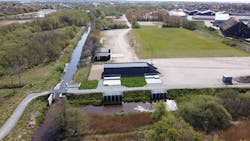Denmark builds new pump stations for flood resistance
Looking ahead at rising sea levels, water utilities in low-lying areas need to plan to handle an increased risk of flooding. In Denmark, flood defenses in the Ringkøbing Fjord have been bolstered by the installation of two new pumping stations, which were designed and equipped by Sulzer. The new facilities will help to protect the town and the surrounding countryside for the next 40 years and far beyond.
Having been reclaimed from the sea, the land surrounding Ringkøbing in west Denmark is protected by a series of dikes and a sea lock, which have successfully kept the water at bay. However, projections for the average water level in the area expect it to rise by 600 mm by 2060, which has led the local water utility, Ringkøbing-Skjern Forsyning A/S, to implement a large-scale development of the drainage and flood defense systems.
Designing for the Future
Once the basic design concept had been established, a technical evaluation was completed to determine the most suitable supplier to partner with the water utility. Sulzer was selected as the Tier 1 construction partner and appointed to deliver the two pumping stations.
Based on the outline for the scheme and the projected figures supplied, Sulzer specified the pumps and designed the pipework to deliver a system that would handle the forecasted water levels until 2060. At that point, the lock will be permanently closed and the pumping stations upgraded to enable them to operate as the only means of drainage in the area.
Virtual Planning
To support both the water utility and the contractors working on site, Sulzer created a virtual reality simulation of the pumping stations. This enabled those involved in the project to see exactly how the scheme would work and how the equipment would be arranged. It was especially useful for the contractors installing the concrete work that would make up the collection and discharge areas for the water.
Each pumping station was designed with a base load pump to handle the day-to-day drainage water and three or four peak load pumps, which operate in a duty/assist/standby arrangement. The Ringkøbing and Skælbækker stations will have a pumping capacity of 1,582 liters per second (417 gallons per second) and 2,254 liters per second (595 gallons per second) respectively.
Built to Last
For this project, Sulzer specified its VUPX vertical column pump for the peak load task and the XFP submersible for the base load. Each pump design has been fine-tuned for this application and has proven performance in thousands of installations around the world. Their build specifications include IE3 motors, which provide reliable and energy efficient operation.
Manufactured with double mechanical seals, stainless steel components and long-life, heavy-duty bearings, these pumps are designed for extended periods of reliable operation between maintenance intervals. All nine Sulzer pumps were delivered according to the build schedule and the overall project was completed on time.
About the Author
Kasper Fredriksen
Kasper Fredriksen is a sales engineer at Sulzer.



